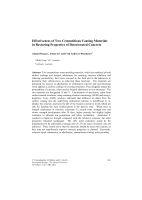Bridges

- Publication no: ABC-SAS003-11
- Published: 31 October 2011
- PDF (free) Download
Two cementitious water-proofing materials, which are marketed as both surface coatings and integral admixtures for restoring concrete alkalinity and reducing permeability, have been assessed in the field and in the laboratory to determine their effectiveness in achieving these functions. The materials are promoted for passive re-alkalisation of carbonated concrete and pore-blocking when applied as surface coatings on existing structures. They allegedly reduce the permeability of concrete, when used as integral admixtures in new structures.
The two materials are designated X and Y. Examination of specimens, taken from surface-treated structures, using scanning electron microscopy (SEM) and energydispersive X-ray (EDX) analysis, indicated that diffusion of alkali from the surface coating into the underlying carbonated concrete is insufficient to realkalise the concrete, and raise the pH of the treated concrete to levels which are safe for keeping the steel reinforcement in the passive state.
When used as integral admixtures in concrete, admixture X, caused some strength loss and slower strength development after 28 days, higher porosity but slightly higher resistance to chloride ion penetration and better workability.
Admixture Y resulted in improved strength compared with the reference concrete, but other properties remained unchanged.
The 10% water reduction, stated by the manufacturer to be achievable at dosage rate of 1.5% by mass of cement, was not achieved. These results show that the materials should be used with caution, as they may not significantly improve concrete properties as claimed.
